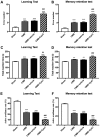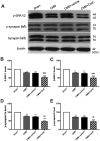Cystatin C promotes cognitive dysfunction in rats with cerebral microbleeds by inhibiting the ERK/synapsin Ia/Ib pathway
- PMID: 32104295
- PMCID: PMC7027318
- DOI: 10.3892/etm.2019.8403
Cystatin C promotes cognitive dysfunction in rats with cerebral microbleeds by inhibiting the ERK/synapsin Ia/Ib pathway
Abstract
Although higher serum level of cystatin C (CysC) was observed in patients with cerebral microbleeds, its associated role in the disease has not been elucidated. In this work, a rat model of cerebral microbleeds was created with the aim of investigating effects of CysC on cognitive function in rats with cerebral microbleeds and the underlying mechanism. Serum samples of patients with cerebral microbleeds and healthy people of the same age were collected. Levels of cystatin C expression in these samples were measured using CysC kits. Moreover, 48 spontaneously hypertensive rats (SHRs) bred under specific pathogen-free (SPF) conditions were randomly divided into 4 groups: sham surgery control group (sham), model group (CMB), model + empty vector control group (CMB + vehicle), and model + cystatin C overexpression group (CMB + CysC). Expression levels of CysC in hippocampus of rats in each group were measured by western blot analysis. The Y-maze was used to evaluate cognitive function of rats. Hippocampal long-term potentiation (LTP) in rats was assessed by the electrophysiological assay. Alterations in levels of p-ERK1/2 and p-synapsin Ia/b proteins associated with cognitive function were identified by western blot analysis. The serum levels of CysC in patients with cerebral microbleeds were significantly upregulated (P<0.001). After injection of CysC, its expression levels in rat hippocampus were significantly increased (P<0.001), which enhanced the decline in learning and memory function, as well as the decrease of LTP in the rat model of cerebral microbleeds (P<0.001). Western blot results showed that injection of CysC further reduced the levels of p-ERK1/2 and p-synapsin Ia/b in the rat model of microbleeds (P<0.001). CysC was up regulated in serum of patients with cerebral microbleeds. It promoted cognitive dysfunction in rats with microbleeds by inhibiting ERK/synapsin Ia/Ib pathway.
Keywords: brain microbleeds; cognitive function; cystatin C.
Copyright © 2020, Spandidos Publications.
Figures





Similar articles
-
Associations between biomarkers of renal function with cerebral microbleeds in hypertensive patients.Am J Hypertens. 2015 Jun;28(6):739-45. doi: 10.1093/ajh/hpu229. Epub 2014 Dec 12. Am J Hypertens. 2015. PMID: 25498995
-
Association Between Serum Cystatin C Level and Total Magnetic Resonance Imaging Burden of Cerebral Small Vessel Disease in Patients With Acute Lacunar Stroke.J Stroke Cerebrovasc Dis. 2017 Jan;26(1):186-191. doi: 10.1016/j.jstrokecerebrovasdis.2016.09.007. Epub 2016 Oct 7. J Stroke Cerebrovasc Dis. 2017. PMID: 27727072
-
Elevated Cystatin C Levels Are Associated with Cognitive Impairment and Progression of Parkinson Disease.Cogn Behav Neurol. 2016 Sep;29(3):144-9. doi: 10.1097/WNN.0000000000000100. Cogn Behav Neurol. 2016. PMID: 27662452
-
Estimating renal function in children: a new GFR-model based on serum cystatin C and body cell mass.Dan Med J. 2012 Jul;59(7):B4486. Dan Med J. 2012. PMID: 22759853 Review.
-
Cystatin C in Cerebrovascular Disorders.Curr Neurovasc Res. 2017;14(4):406-414. doi: 10.2174/1567202614666171116102504. Curr Neurovasc Res. 2017. PMID: 29149834 Review.
Cited by
-
Insulin-producing cell clusters derived from human gingival mesenchymal stem cells as a model for diabetes research.Mol Biol Rep. 2022 Dec;49(12):11973-11982. doi: 10.1007/s11033-022-08008-6. Epub 2022 Oct 21. Mol Biol Rep. 2022. PMID: 36271309
-
Association between Serum Cys C and PTB Cavitation.Dis Markers. 2023 Apr 12;2023:6465182. doi: 10.1155/2023/6465182. eCollection 2023. Dis Markers. 2023. PMID: 37091891 Free PMC article.
-
Anti-inflammatory, cardioprotective effect of gypenoside against isoproterenol-induced cardiac remodeling in rats via alteration of inflammation and gut microbiota.Inflammopharmacology. 2023 Oct;31(5):2731-2750. doi: 10.1007/s10787-023-01307-9. Epub 2023 Aug 21. Inflammopharmacology. 2023. PMID: 37603159
-
The Effect of Continuous Positive Airway Pressure (CPAP) Therapy on Serum Caspase-3 Level in Patients with Obstructive Sleep Apnea (OSA).Sleep Breath. 2024 Aug;28(4):1597-1607. doi: 10.1007/s11325-024-03039-8. Epub 2024 Apr 29. Sleep Breath. 2024. PMID: 38683249
-
The Anti-proliferative Effect, Apoptotic Induction, and Cell Cycle Arrest of Tetra Halo Ruthenate Nanocomposites in Different Human Cancer Cell Lines.Cell Biochem Biophys. 2025 Mar;83(1):865-877. doi: 10.1007/s12013-024-01519-y. Epub 2024 Oct 15. Cell Biochem Biophys. 2025. PMID: 39406967
References
-
- Charidimou A, Imaizumi T, Moulin S, Biffi A, Samarasekera N, Yakushiji Y, Peeters A, Vandermeeren Y, Laloux P, Baron JC, et al. Brain hemorrhage recurrence, small vessel disease type, and cerebral microbleeds: A meta-analysis. Neurology. 2017;89:820–829. doi: 10.1212/WNL.0000000000004259. - DOI - PMC - PubMed
LinkOut - more resources
Full Text Sources
Miscellaneous
